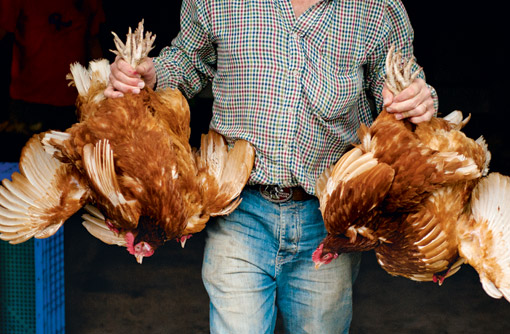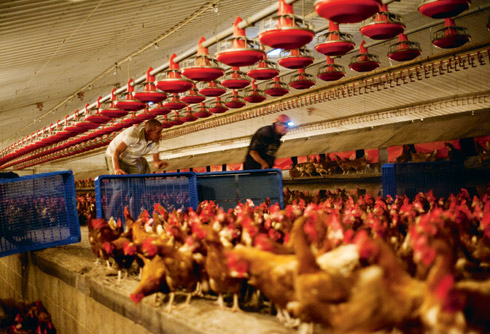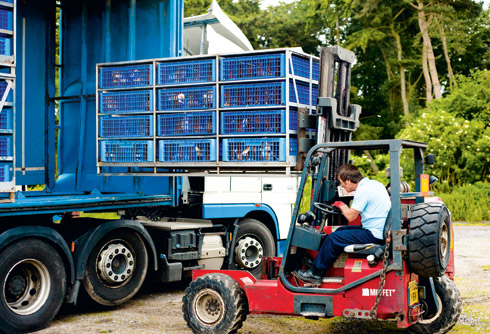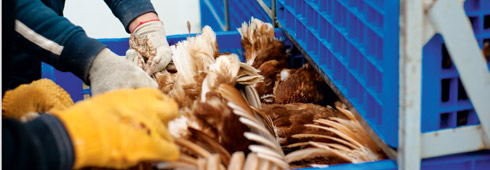Getting it right with hen depletion

Depopulating spent hens can be a stressful and time-consuming job – but advance planning will ensure the day goes smoothly. Olivia Cooper finds out what’s involved
Co-ordinating an entire catching team, and overseeing depopulation from farm to processor requires excellent organisational skills. A relatively straightforward task if everything goes according to plan, it can turn to disaster if just one part of the chain goes awry.
Most egg producers simply hire in the expertise of a catching team. But a severe shortage of approved teams in the South West means an increasing number of farmers in the region are looking to organise it themselves.
Under the RSPCA’s Freedom Food scheme, producers must now be approved before they can organise their own depopulation of laying hens. As such, the West Country Layers’ Association and Duchy College have created a depopulation training course.
Based on best practice across the industry, it is just as relevant to non-Freedom Food producers who simply want to make their depopulation run as smoothly as possible.
ADVANCE PLANNING
Under the Freedom Food scheme rules, all catching team leaders must create a Depopulation Action Plan for each shed, up to one month prior to depopulation. Considerations include the number of birds and their weight, potential access problems, ground conditions, space in the loading area and who will supply any catching frames.
“Request that everybody is on site at least half an hour prior to the planned start time, to enable loading procedures to be distributed, read and signed,” says training provider John Moore.
A separate catching plan must also be devised and shared, including the catching route and handling plan. “Identify the best route to the modules, which minimises steps and hazards for your catchers.”
The health and safety of staff is paramount. In deep pit houses, producers may be governed by the Work at Height regulations, so need to be particularly wary of stacking modules to reach the shed.
Defining responsibilities is also important, Mr Moore adds. “Who will pick up loose birds? Who will kill any casualties? And when will they do so? It helps to plan the number of birds caught per person to multiples of the drawer stocking density – for example four people equals 24 birds per drawer.”
Producers should also consider how to protect birds from adverse weather – and be aware that side-loading lorries are not permitted for Freedom Food birds.
LEGAL OBLIGATIONS
Under the Welfare of Animals (Transport) Order 1997, all producers are obliged to treat the birds in a way that does not cause them injury or unnecessary suffering.
The Welfare Code states that birds must not be deprived of feed or water before transport. “However, feed, but not water, may be withheld for up to 12 hours prior to slaughter.” This includes the catching, loading, travelling and unloading time, so it is essential that producers co-ordinate collection times with the slaughterhouse timetable, says Mr Moore.



Before depopulating a house, producers must remove any hindrance from fixtures and fittings like feeders and drinkers, especially those with sharp edges or protrusions. By identifying the catching area, producers can leave drinkers set up in the rest of the shed, and only disturb birds in the immediate vicinity of the catching area.
“You want to collect birds close to the catching pen first – don’t walk them up from the back of the shed each time as they are more likely to smother. Shut the nest boxes, and have one person responsible for collecting the birds, with another waiting in the catching pen.”
Under Freedom Food requirements, birds must be caught under low level lighting, not complete blackout, to help calm the hens while also reducing the risk of injury.
“Care must be taken in catching birds in order to avoid panic,” says the Welfare Code. “The proper handling of birds requires skill, and it should be undertaken only by competent persons who have been appropriately trained. It should be carried out quietly and confidently, exercising care to avoid unnecessary struggling, which could bruise or otherwise injure the birds.”
MAKE LIFE EASY
A catching frame is useful for flighty birds, and producers should place the modules as close to the catching area as possible to minimise the carrying distance, says Mr Moore. “Your team needs to understand bird behaviour – avoid sudden movements and loud bangs which will cause panic. The size of the catch pen should be no larger than 300-400 birds. Walk the entire shed down at the end, to round up any stray birds.
“You also need to have a system of communication between the handlers that will work with low lighting and lots of noise. And use blue headlights on telehandlers and lorries to decrease stress – chickens can’t see in blue lighting, so that’s a lot better than white headlights swinging around.”
It is now mandatory for loose-housed birds to be caught and held by both legs, as carrying them by one leg can cause bruising and dislocation of the hip joints. “Hold the shank of the legs so as not to bruise the muscle, and if the bird starts flapping, gently rest its breast against your leg to calm it down.”
Catchers must carry a maximum of three birds per hand, and not cross the legs over. It is also important to limit the transfer of birds between handlers to two handovers. “You can’t have a chain gang of people passing them on. Lower them gently into the trays on their breast, and allow them to regain their balance before you add more birds.”
CONSIDER THE WEATHER
Drawers should allow a minimum space of 160cm2/kg liveweight, with the stocking rate reduced by 20% in hot weather (over 21C).
“Fill the modules on the lorry from the top down to prevent trapping the birds underneath, and be careful when shutting them. Leave a gap between the rows to keep air circulating until you get the last modules in,” says Mr Moore. “The time between the loading of the last hen to the time of arrival at the final destination must be less than eight hours.”
Under the Welfare Code, birds must be protected from bad weather, and excessively hot or cold conditions. “They should not be allowed to become stressed (as indicated by prolonged panting). Adequate ventilation is essential at all times.”
Birds that cannot be transported because they are ill or injured should be given prompt veterinary treatment or humanely dispatched without delay, he adds. “You need to have someone on site who is trained and capable of killing any casualties as humanely as possible, ideally by cervical dislocation.”
CONTINGENCY PLANNING
It is the depopulation leader’s responsibility to plan for any potential problems, including late arrival of the catching team or lorry, machinery breakdown and so on.
“If you have a delay of up to three hours, you need to build that into the arrival time at the processors. If it’s over three hours, consider whether you have enough poultry food available to keep the birds. Do the driver’s hours restrict his ability to deliver the birds within the processing timetable? And if you have to reschedule, do you have all the necessary phone numbers to hand?”
FINAL PAPERWORK
Once all the birds are loaded, the catching team may be keen to head off, but it is important that they review the day’s procedures, says Mr Moore. Mortality, injuries and culls must be recorded, both on farm and on arrival at the abattoir, and actions set out to reduce these incidences in the future.
“If you have more than 0.5% mortality it has to be reported to Freedom Food and investigated. You should be targeting zero injuries and mortality – there should be no physical damage as a result of loading. That is entirely possible if you do everything right.”
Responsibilities during depopulation
• Producer or named supervisor – ultimately responsible for the welfare of the birds, until they are loaded into the transport modules
• Catching team leader – responsible for supervising the catching process, making sure all catching team members are aware of their duties and are competent to carry them out
• Senior members of the catching team – experienced members of the catching team, appointed by the team leader, need to help supervise other members of the team
• Haulier / driver – responsible for making sure all birds are fit to travel and for their welfare from the time they are placed into the transport modules until they are unloaded at the abattoir.
